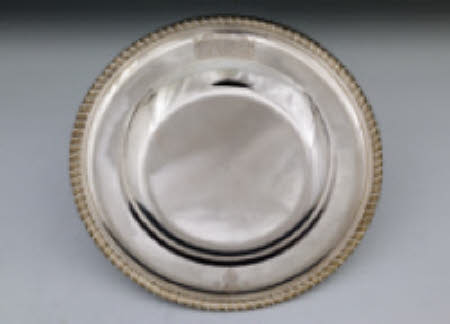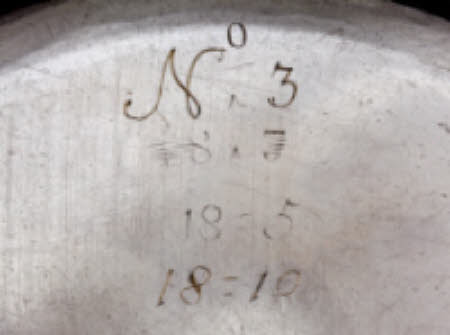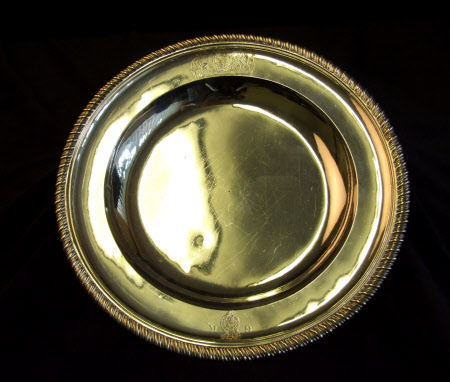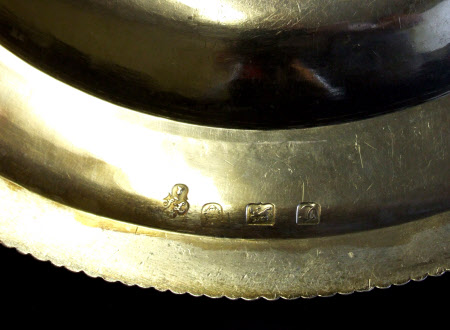Twelve soup plates
Simon Le Sage
Category
Silver
Date
1758 - 1759
Materials
Sterling silver
Measurements
2.5 cm (Height); 24.8 cm (Diameter)
Place of origin
London
Order this imageCollection
Ickworth, Suffolk
NT 852125
Summary
Twelve soup plates, sterling silver, marked by Simon Le Sage, London, 1758/9. The circular plates are raised with deep wells and broad rims to which have been applied moulded and gadrooned cast borders. Heraldry: Each plate is engraved on its rim with both the quartered arms of the Hanoverian monarchs (pre-1801) within the Garter and beneath an imperial crown flanked by the letters G R and, opposite, the quartered shield, supporters and motto of the 2nd Earl of Bristol in an ermine mantling and beneath an earl’s coronet. Hallmarks: Nos. 4, 6, 8, 10 and 12 have no hallmarks. The remainder are fully marked on their undersides with date letter ‘C’, lion passant, leopard’s head and maker’s mark ‘S∙L’ in italics with a cup above and mullet below (Arthur Grimwade, London Goldsmiths 1697-1837, London 1990, no. 2576). Scratchweights: ‘Nº 1 [/] 19=0’; ‘Nº 5 [struck through] 2 [/] 18=19’ plus old scratch ‘Nº۸ 2 [/] [-] 5 –’; ‘Nº۸ 3 [/] 18 ۸ 1 [struck through][/] 18=5 [faint] [/] 18=10 [actual scratchweight]; ‘Nº. = 4 [/] 18=15’; ‘Nº 5 [/] 19=0’; ‘Nº 6 [/] 19=0’; ‘Nº۸ 7 [/] 19 ۸ 8 [struck through][/] 19=6 [faint] [/] 18=15 [actual scratchweight]’; ‘Nº 8 [/] 19=0’; ‘Nº۸ 9 [/] 19 ۸ 18 [faint] [/] 18=16 [actual scratchweight]’; ‘Nº = 10 [/] 19=1’; ‘Nº. 11 [/] 19=3 plus [faint] ‘Nº۸ 11 [/] 19 ۸ 11 [struck through][/] 19=13; ‘Nº 12 [/] 18=11’ plus [faint] ‘Nº۸ 3 [/] 39=10[/] 38=16’.
Full description
These are the only items amongst the 2nd Earl of Bristol’s plate that bear both the royal arms and his own, the latter almost certainly being executed in Spain by an engraver who was not used to English armorials as is particularly evident in the rendering of the coronets. The reason for the addition must be that these plates did not form part of the official allocation on being appointed ambassador to Spain and Lord Bristol wanted to make that very clear. They are not listed in the Jewel Office records and they were most probably purchased out of the £100 down payment that had been made in September 1758 to ensure that work started on the overall order (see NT 852077). They bear evidence of being formed out of other items, having old scratchweights and centring marks as well as distorted hallmarks. Le Sage may even have used some of the pieces presented to the Jewel Office to extract funding for the fashion of the candelabra, the old scratchweights tallying with the average weights of the dozen round dishes and the four dozen plates.[1] The simple form of these soup plates, not matching Lord Bristol’s others, suggests that they were intended to form part of his everyday service of silver, rather than to be used on grand occasions. James Rothwell, Decorative Arts Curator June 2021 [Adapted from James Rothwell, Silver for Entertaining: The Ickworth Collection, London 2017, cat. 78, p. 166] Note: [1] These average weights are 39oz 18 dwt and 17oz 17dwt.
Provenance
George Hervey, 2nd Earl of Bristol (1721-75); by descent to the 4th Marquess of Bristol (1863-1951); accepted by the Treasury in lieu of death duties in 1956 and transferred to the National Trust.
Credit line
Ickworth, the Bristol Collection (National Trust)
Makers and roles
Simon Le Sage, goldsmith






